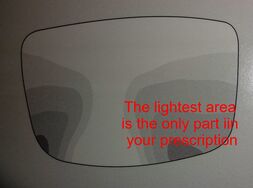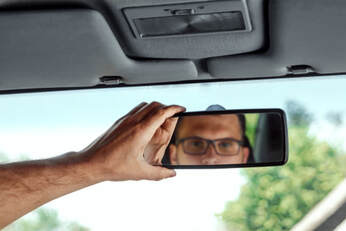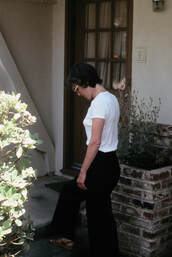
Taming My Bifocal- your bifocal is not your enemy!

Choose Your Poison
You need to choose your poison.
You need to choose your poison.

People commonly believe it is difficult to adapt to a bifocal, and it is true for some. Yet, why is it difficult? Usually another vision condition is the culprit. Two main conditions make adaption difficult. One is an eye turn and the other is eyestrain. So much energy is used for these conditions that there is little energy left to adapt to that line or distortion in your vision.
|
|
Why a Bifocal, not a Progressive?
The PAL is marketed mainly for cosmetics. No one can see your bifocal line. Thus, no one can look at your glasses and tell if you hit your mid forties. |
|
The PAL is especially narrow for your middle distance like computer screens and price tags on shelves. It is so narrow we make a special measurement to see if one eye is closer to your nose. If missed, one eye would see in the channel while the other would look through distortion.
|
|

Most progressives have a clear reading area of only 5 inches at the typical sixteen inch reading distance. Many people struggle to find the sweet spot for each point from distance to a reading distance. The above picture of a progressive shows the areas of distortion. The darkened areas to the side are someone’s else’s prescription as the lens progresses from your distance to near vision.
No, a PAL is really not your pal.
No, a PAL is really not your pal.

The PAL is a molded lens that starts with your distance vision prescription in the upper 10% of your glasses. Through varying curvatures, it ends at your near prescription in the lower 10% of your glasses.
As you move your eyes down this narrow channel, the power progressively gets stronger-hence its name. Everywhere else is distorted.
As you move your eyes down this narrow channel, the power progressively gets stronger-hence its name. Everywhere else is distorted.

Why is the area outside the channel someone else’s prescription?
A prescriptive lens has a curvature. The steeper the curve, the stronger the prescription. The curvature of the PAL gradually increases steepness from the top to the bottom of the lens. Since the PAL is molded, like a jell-O mold, the section of the lens outside the channel must also be curved. Those curves do not match your prescription. If you’ve ever put on someone else’s glasses, you can see the distortion from that.
A prescriptive lens has a curvature. The steeper the curve, the stronger the prescription. The curvature of the PAL gradually increases steepness from the top to the bottom of the lens. Since the PAL is molded, like a jell-O mold, the section of the lens outside the channel must also be curved. Those curves do not match your prescription. If you’ve ever put on someone else’s glasses, you can see the distortion from that.

A lined bifocal does not do that. It is fused. The lens starts with your distance prescription. A section is carved out on the bottom and another lens with your near vision prescription is placed in the carved-out section. Thus, every portion of the bifocal lens is your prescription.
Usually, 50 to 60% of the top of your lined bifocal is entirely your distance prescription. The whole width of the lined bifocal segment is your near-vision prescription.
Usually, 50 to 60% of the top of your lined bifocal is entirely your distance prescription. The whole width of the lined bifocal segment is your near-vision prescription.
You have clear vision across the entire page rather than the five inches limited with a progressive. You immediately see clearly no matter where you look, even the sides. You don’t have to move your head when reading, required by a PAL. Accordingly, you do not slow reading down and interfere with vision processing which the progressive does. Head movement slows down vision processing.
A Bifocal Mimics Natural Vision
Our eyes change focus immediately when we look from distance to reading up close. They do not progressively change like a slide projector zooming in and out. It is immediate. You want immediate clarity, and hunting for a sweet spot in the PAL slows vision function down.
Yes, there is a line to contend. Yet, people who do not have an eye turn or eyestrain mentioned earlier, normally adapt within a few minutes if not within three days. Some adapt immediately.
A Bifocal Mimics Natural Vision
Our eyes change focus immediately when we look from distance to reading up close. They do not progressively change like a slide projector zooming in and out. It is immediate. You want immediate clarity, and hunting for a sweet spot in the PAL slows vision function down.
Yes, there is a line to contend. Yet, people who do not have an eye turn or eyestrain mentioned earlier, normally adapt within a few minutes if not within three days. Some adapt immediately.
|
Why does a PAL interfere with vision processing and reading speed? Because of the very narrow channel, you have to move your head to read. When you move your head, vision processing skills shut down and auditory processing opens up. Thus your reading speed drops to a maximum of 250 words per minute-about as fast as you can talk. Imagine what giving a progressive to a student does to the student’s academics. Go to FAQ and read about God knew we were going to play baseball. |
|
|
|
Special Bifocals
Desktop computer screens present a problem whether you have a bifocal or a PAL. You have to tip your head back to view the screen through the near vision section. We have special computer bifocals where the top is set for that slightly further distance of the computer screen and the reading segment is for regular close work. PAL's attempt to do the same but still have a narrow view for both the computer screen and reading. Some occupations like carpenters, auto mechanics, and electricians require bifocals positioned in unique positions. Would anyone prescribe and fit a metal frame for an electrician! If you have any of those jobs ask us how we can make your work more comfortable. |

How do I adapt to my Bifocal?
3 steps
1. Lower your chin if the reading segment gets in your way at distance. If the car in your rear-view mirror looks fuzzy, simply lower your chin and lift your eyes to avoid the reading segment.
3 steps
1. Lower your chin if the reading segment gets in your way at distance. If the car in your rear-view mirror looks fuzzy, simply lower your chin and lift your eyes to avoid the reading segment.
|
|
2. Rather than raise your chin, hold reading material near your waist when the distance section is in your way. You could raise your chin, but who wants to drown in the rain? As an example, always fold your newspaper and hold it in your lap or on the table so you can glance easily through the reading segment without raising your chin. If you held the paper at its full length with arms extended you have to raise your chin to see through the reading segment.
|

3. Look over the top of the bifocal line when on stairs or stepping off curbs. If you look through the reading segment, not only will the stairs appear blurry, they will appear to be at a different distance.
You would then probably miss your step and even trip.
You would then probably miss your step and even trip.

Note: The golf thing! Some golfers fear the line will get in the way of their swing and request golf glasses with the reading segment placed lower. We now may have found a golfing problem. One of the biggest problems in hitting a golf ball is raising your head as you swing. With the bifocal you have to keep your head down.
How do I adapt to My Progressive?
There are no special steps like we described above for a bifocal. In addition to moving your head up and down and sideways, you have to learn to tolerate distortions and small areas of clear vision.
How do I adapt to My Progressive?
There are no special steps like we described above for a bifocal. In addition to moving your head up and down and sideways, you have to learn to tolerate distortions and small areas of clear vision.
Yes, many patients desire the progressives and we provide them. Not only do we provide them, we make sure they are measured correctly for you to give minimal discomfort. Don’t worry if you find the progressive intolerable, we will supply a lined bifocal if you return your progressive within two months.
WARNING:
Whether you have a bifocal or a PAL be careful during the first few days of adaption (up to two weeks for a progressive). You could miss your step on the stairs or pour coffee on the table rather than the cup, etc.
WARNING:
Whether you have a bifocal or a PAL be careful during the first few days of adaption (up to two weeks for a progressive). You could miss your step on the stairs or pour coffee on the table rather than the cup, etc.

